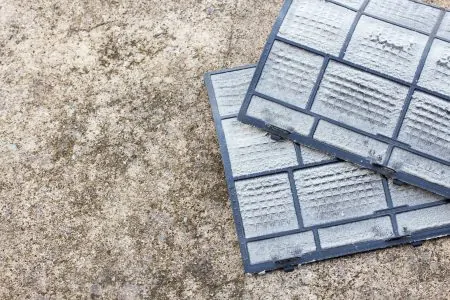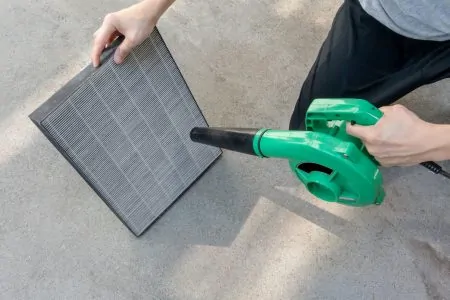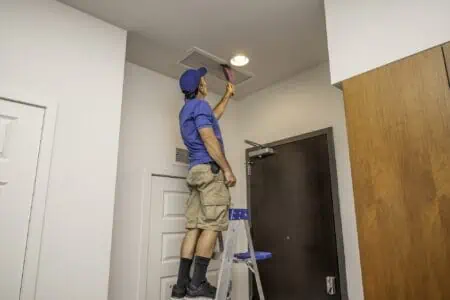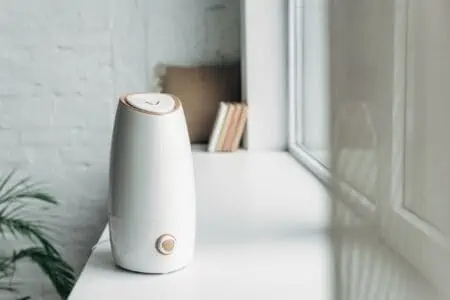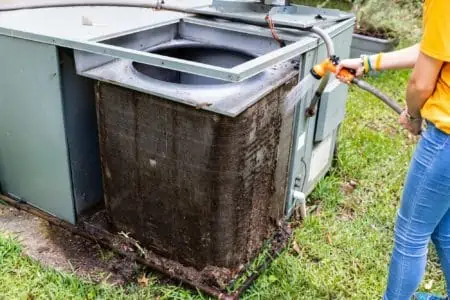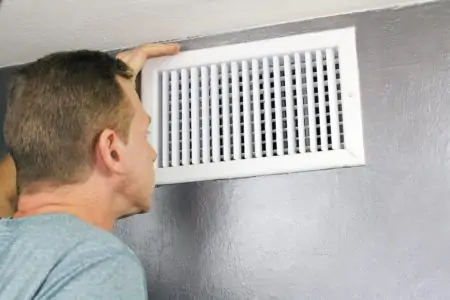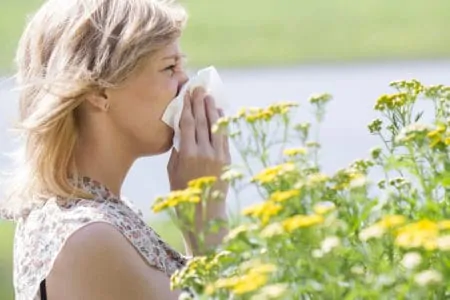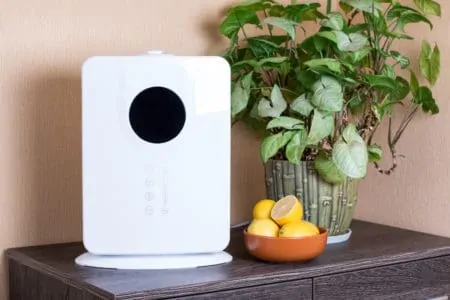A HEPA filter is an essential part of an air purifier. It’s also commonly used in vacuum cleaners and respiratory masks. However, when used in air purifiers, there are many misconceptions about what the filter can and can’t do.
There are many types of HEPA filters, some of which aren’t genuine HEPAs. This is crucial to know, especially if you’re buying an air purifier to reduce allergens.
How can you make sure you’re getting the right filter? Let’s take a closer look at what HEPA filters are, various types, and how they work. Plus, if you’re wondering whether they’re worth it, we’ll help you decide.
Key Takeaways
- HEPA filters remove 99.97% of particles as small as 0.3 microns, including dust, allergens, and mold.
- Genuine HEPA filters are more effective than HEPA-type or HEPA-like filters, which don’t meet the same standards.
- HEPA filters don’t remove volatile organic compounds (VOCs) or viruses and can become contaminated with mold if not replaced regularly.
- It’s crucial to replace HEPA filters every 12 to 18 months or when needed to maintain air quality and filter effectiveness.
What Is a HEPA Filter?
HEPA — commercialized during the 1950s — is short for high-efficiency particulate air. These filters are commonly used in applications where contamination control is needed. This includes medical devices, food, and pharmaceutical products.
HEPA filters are generally made up of a fiberglass mat that traps pollutants and particles as they pass through. The standard for HEPA filters differs between the U.S. and Europe. However, the U.S. standard is that the filter must capture at least 99.97 percent of particles at 0.3 microns (1).
What Are Microns?
You’ll likely come across microns when you’re learning about HEPA filters or researching appliances such as air purifiers. Microns, also known as micrometers, are one-millionth of a meter and are the standard way to measure particles (2).
Let’s put microns into perspective; we can’t see particles less than 10 microns. Keep in mind that HEPA filters will capture particles as small as 0.3 microns. This includes dust, allergens, bacteria, mold, and more.
Types of HEPA Filters
HEPA filters come in different variations. These are generally marked as HEPA-type, HEPA-style, or HEPA-grade. Because of this, manufacturers are beginning to use the term “True HEPA.”
As we covered above, a HEPA filter must remove 99.97 percent of airborne pollutants as small as 0.3 microns to meet the standard. This means only a few particles should be able to escape the filter.
Simply because a product mentions HEPA-type or style doesn’t mean that it meets the standard. Now, many manufacturers produce the filters using the same materials as a true HEPA, but where they fail is in construction.
For a filter to be effective, it has to be within an airtight case. If air can escape around the filter, it won’t be as effective. This is often the most significant difference between high-end air purifiers and cheaper devices.
HEPA and HEPA-Type Effectiveness
As you’re looking at HEPA filters, you might come across the term MERV. This is short for Minimum Efficiency Reporting Value and is used to rate the overall effectiveness of an air filter (3).
HEPA filters generally hold a rating of MERV 17 but may fall anywhere between 13 and 17. HEPA-type or HEPA-like filters generally hold a MERV rating between nine and 12. These filters will also only capture particles between one and three microns.
As you can see, there’s a significant difference between true HEPA filters and HEPA-type. So, if you want to improve your indoor air quality, go for a true HEPA filter.
How Does a HEPA Filter Work?
High-efficiency particulate air filters trap contaminants as they pass through a web of fibers. As the pollutants pass through the filter, they’re trapped in one of four stages: diffusion, interception, inertial impaction, and sieving (4).
Larger particles are trapped within the inertial impaction and sieving. The particles are captured as they collide with the fibers or when they attempt to go through the fibers. Medium-sized particles are captured by the interception fibers, whereas small particles are dissipated and eventually trapped by the fibers.
Advantages of HEPA Filters
Because of the fine fibers that HEPA filters are made of, individuals who suffer from allergies or asthma can feel a significant difference (5).
The fine mesh-type fibers will effectively capture common allergy triggers such as dust mites and mold spores. If you have pets in your home, a HEPA filter will trap pet dander.
HEPA filters can also help your HVAC system by trapping dust and dirt, preventing them from building up within the system. You can install the filters within the system or utilize an air purifier near the air intake.
Disadvantages of HEPA Filters
As good as HEPA filters are, they do come with a few flaws. Here are a few points to keep in mind:
1. Small Particles Can Escape
Despite their high efficiency, HEPA filters won’t capture every particle. Harmful pollutants such as bacteria, allergens, and viruses range in size; many are smaller than 0.3 microns. This means the HEPA filter won’t trap them.
You might feel an improvement in air quality, but sensitive individuals with allergies or asthma might still be affected.
2. Won’t Trap VOCs
Volatile organic compounds are common but harmful indoor air pollutants. VOCs within a household generally derive from certain cleaning and beauty products.
VOC exposure can lead to nausea, dizziness, headaches, liver damage, and more. Studies have shown that VOC levels are two to five times higher indoors than outdoors (6). Unfortunately, HEPA filters cannot trap VOCs because the particle size is too small.
3. Won’t Remove Viruses
Viruses are also too small for HEPA filters to remove.
Despite this, many manufacturers have previously advertised that HEPA filters would remove and protect you from viruses. However, new FTC regulations ensure that manufacturers can’t make this claim any longer.
4. Can Become Contaminated
As mentioned above, HEPA filters will capture mold and bacteria, which can also cause trouble.
Bacteria are known to release endotoxins back into the air stream while dying within the filter. These can cause atopic and inflammatory effects in asthmatic and nonasthmatic individuals (7).
If you have problems with mold within your home, the HEPA filter can become a thriving spot.
As the filter captures mold spores, they remain alive. Mold spores can live in extreme conditions, such as drought and high temperatures. They can typically thrive even in environments that mold itself can’t survive (8).
The warm, dark space within the fibers provides a comfortable spot for the spores. As other bacteria and pollutants are caught, the spores are provided with nutrients. Mold can eventually begin to grow within the filter, releasing new spores back into your living space.
Are HEPA Filters Worth It?
As mentioned above, HEPA filters have flaws, especially regarding gases and tiny particles. If you or another person in your house has allergies or asthma, a HEPA filter will help to reduce allergens.
However, if you want to remove or reduce harmful pollutants such as VOCs, viruses, or bacteria, you must look elsewhere. For this purpose, air purifiers with an activated carbon filter alongside the HEPA — which absorbs VOCs — will be helpful (9).
Overcoming the Flaws of HEPA Filters
If you’re using a HEPA filter in your home but are still concerned about certain pollutants, you can compensate. Here are a few tips for overcoming the flaws of HEPA filters:
- Clean regularly: By vacuuming, dusting, and mopping regularly, you can limit the pollutants in your home. HEPA filters also won’t be able to remove particles trapped in thick carpets, furniture, or curtains.
- Reduce harmful fumes: After cleaning, ensure you air the room well. Keep a few windows open while cleaning — VOCs are commonly found in disinfectants, solvents, and aerosol sprays.
- Limit pets: Consider limiting where your pets spend time. For example, keep the nursery or bedroom closed off to prevent lingering pet dander and hair.
- Increase ventilation: Because indoor air quality tends to be poorer than outdoors, airing out occasionally can help. Open a few windows or doors and let some fresh air come in.
How Often Should a HEPA Filter Be Replaced?
Replacing the HEPA filter in your air purifier is vital. As you can imagine, the filter will become saturated with pollutants and contaminants over time. So if you fail to replace the filter, its efficiency and the air purifier’s effectiveness will lower.
Most manufacturers will provide you with an estimated replacement time. However, the time to replace your filter depends on a few factors:
- Air quality: The air quality inside your home significantly affects how long a filter will last. If your air is very polluted, you should expect a shorter lifespan from your filter. Maybe you live close to a busy road, have pets, or a smoker in the house — these can quickly fill a filter.
- Usage: Some homeowners choose to run their air purifiers throughout the day — some even 24/7. This will also require more maintenance. To save your filter and energy bills, consider when you need the purifier the most.
You can find more high-tech air purifiers with a filter monitor. These features will calculate how often the filter is used and how polluted the air is. The air purifier indicates when it requires a replacement.
In general, you should replace HEPA filters every 12 to 18 months.
Further, look for the following signs that your filter needs to be replaced:
- The filter looks dirty or gray.
- You notice an increase in allergens.
- Your home is dustier.
- You begin to experience allergy-like symptoms, such as sneezing or coughing.
FAQs
Functioning Filter
High-efficiency particulate air filters are one of the most effective and commonly used filters. Although there are many types of HEPA filters, a genuine HEPA filter must meet a certain standard. In the U.S, a HEPA filter has to be able to remove up to 99.97 percent of pollutants at the size of 0.3 microns.
HEPA filters will effectively remove most allergens, dust, pollen, and mold from the air. However, they won’t remove viruses or VOCs. Mold can grow within the fibers, so it’s essential to replace it regularly every 12 to 18 months or when needed.
